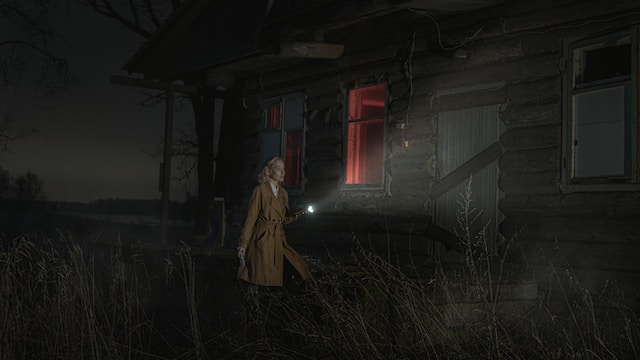
As the rain poured down on the deserted streets, Private Investigator Jack Johnson trudged through the puddles, his fedora pulled down low over his eyes. He had a feeling that tonight was going to be a long one.
Johnson had been hired by an aging heiress to find her missing son. The young man had disappeared without a trace, and the police had all but given up on the case. But Johnson had a reputation for solving the toughest of cases, and he wasn’t about to let this one go unsolved.
As he approached the door of the seedy dive bar where the missing man had last been seen, the smell of stale beer and cigarettes filled his nostrils. He pushed through the door and scanned the dimly lit room, his sharp eyes taking in every detail.
The patrons eyed him warily, but Johnson didn’t flinch. He knew that he only had one chance to find the answers he needed, and he was determined to get them.
He approached the bartender and flashed his private investigator badge. “I’m looking for a man named Jimmy,” he said. “I know he was here a few nights ago.”
The bartender’s eyes darted nervously around the room. “I don’t know what you’re talking about,” he said, his voice barely above a whisper.
Johnson leaned in closer. “I think you do,” he said, his voice low and menacing.
The bartender hesitated for a moment before finally speaking. “Jimmy was here,” he said. “But he left with a guy in a black trench coat.”
Johnson thanked the bartender and left the bar, his mind racing with possibilities. Who was the man in the trench coat? And why had he taken Jimmy?
As he walked back out into the rain, Johnson knew that the answers were out there somewhere. He just had to find them before it was too late.
Understanding the Mystery Genre
The passage above is a great example of the mystery genre, with its focus on a tough, determined detective on the trail of elusive clues, shady characters, and a missing person. In this genre, the plot is driven by a puzzle or crime that needs to be solved, often with high stakes involved. The mystery genre has long captivated readers with its intricate puzzles, suspenseful narratives, and intriguing characters. It is a genre that encompasses a wide range of subgenres, from classic detective fiction to psychological thrillers.
History of the Mystery Genre
The origins of the mystery genre can be traced back to ancient times, with early examples of mystery storytelling found in Greek and Roman literature. However, it was not until the 19th century that the mystery genre began to take shape as a distinct and popular genre.

Edgar Allan Poe’s iconic detective character, C. Auguste Dupin, and his tales of deduction set the stage for future mystery authors. Arthur Conan Doyle’s Sherlock Holmes stories in the late 19th and early 20th centuries further popularized the genre, solidifying the archetype of the brilliant detective.
Throughout the 20th century, the mystery genre continued to evolve and diversify. It gave rise to subgenres such as cozy mysteries, featuring amateur sleuths in quaint settings, and hard-boiled detective fiction, with gritty protagonists navigating a corrupt world. Today, the mystery genre remains a dynamic and thriving genre, incorporating elements of suspense, psychological intrigue, and crime-solving.
Elements of Mystery Genre Writing
A compelling plot
A well-crafted plot is the backbone of a compelling mystery. It unfolds in a structured manner, keeping readers engaged and eager to uncover the truth. The following elements contribute to effective plot development:
Introduction of a Crime or Puzzle: The story begins with the introduction of a crime, an unsolved mystery, or a puzzling situation that hooks the readers’ curiosity. This initial incident serves as the catalyst for the ensuing investigation and propels the narrative forward.
Building Suspense and Tension: To maintain readers’ interest, it is crucial to build suspense and tension throughout the story. This can be achieved through skillful pacing, strategic placement of twists and turns, and the gradual revelation of clues and information. Each new development should deepen the mystery and heighten the stakes, leaving readers eager to uncover the truth.
Clues and Red Herrings: Clues play a pivotal role in mystery genre writing. They provide breadcrumbs for both the protagonist and the readers to follow, gradually unraveling the puzzle.

Clues can be physical evidence, witness statements, or subtle details in the narrative. It is essential to balance the inclusion of genuine clues with red herrings—misleading information or false leads that keep readers guessing and add complexity to the plot.
Resolution and Reveal: The resolution of a mystery should tie together all loose ends and provide a satisfying conclusion. The reveal, where the truth is unveiled, should be logical and supported by the clues presented throughout the story. Striking the right balance between surprise and plausibility is key to leaving readers fulfilled and impressed by the writer’s ingenuity.
Setting and atmosphere
The setting of a mystery novel plays a vital role in creating the mood, tone, and overall atmosphere of the story. It enhances the readers’ immersion in the narrative and sets the stage for the unfolding events. Consider the following aspects:
Importance of the setting in creating mood and tone
The choice of setting significantly influences the mood and atmosphere of a mystery. A gloomy and isolated mansion can evoke a sense of foreboding and suspense, while a bustling city with dark alleys and hidden secrets can create a noir-like ambiance. The setting should be carefully described, utilizing vivid imagery and sensory details to transport readers into the world of the story.
Examples of iconic mystery settings
Throughout the history of the mystery genre, certain settings have become iconic. For instance, the foggy streets of Victorian London, as seen in Arthur Conan Doyle’s Sherlock Holmes stories, or the quaint English villages filled with quirky characters in Agatha Christie’s novels. These settings have become synonymous with the genre and contribute to its allure.
Characters in the Mystery Genre
The characters in a mystery novel are instrumental in driving the plot forward and engaging readers. Each character serves a specific purpose in the narrative, contributing to the overall intrigue. Consider the following character types:

- Protagonist (e.g., Detective, Amateur Sleuth): The protagonist is typically the central character tasked with solving the mystery. They can be a professional detective, a private investigator, or an amateur sleuth. The protagonist’s skills, personality traits, and unique quirks shape their approach to solving the mystery and make them relatable to readers.
2. Antagonist (e.g., Criminal, Villain): The antagonist in a mystery novel is the individual or group responsible for the crime or puzzle that drives the plot. They can be a cunning criminal, a mastermind, or a villain with hidden motives. Crafting a compelling and layered antagonist adds depth and complexity to the story, as the protagonist must overcome formidable challenges to solve the mystery.
3. Supporting Characters and Their Roles: Supporting characters fulfill various roles in a mystery novel. They can be witnesses, suspects, allies, or foils to the protagonist. Each supporting character should be distinct, with their own motivations and secrets, contributing to the overall web of intrigue and providing opportunities for unexpected twists and turns.
Writing Style and Techniques
In addition to plot, setting, and characters, the writing style and techniques employed in mystery genre writing greatly influence the reader’s experience. Here are some key considerations:
Point of view choices
The choice of point of view can shape the reader’s perspective and level of engagement. First-person narration can provide a more intimate and subjective experience, allowing readers to delve into the thoughts and observations of the protagonist. Third-person narration, on the other hand, offers a broader view of the story, providing insights into multiple characters’ perspectives and allowing for a more objective narrative.
Dialogue
Dialogue plays a crucial role in mystery genre writing. It serves as a tool for revealing information, advancing the plot, and developing characters. Engaging and authentic dialogue can provide vital clues, uncover hidden motives, and create opportunities for suspenseful confrontations or revelations.
Pacing and maintaining reader engagement
Maintaining a well-paced narrative is vital in keeping readers engaged throughout the story. Carefully timed revelations, cliffhangers, and moments of heightened tension contribute to the overall pacing. Balancing moments of action, investigation, and introspection ensures a dynamic and compelling reading experience.
Incorporating these elements and techniques into your writing will help you create captivating narratives that challenge and entertain readers.
The combination of a well-structured plot, atmospheric settings, compelling characters, and skillful writing will keep readers eagerly turning the pages, eager to unravel the enigmatic puzzle at the heart of the story.

Crafting a Satisfying Resolution
The resolution of a mystery should strike a delicate balance between surprising readers and being plausible within the established narrative. Avoid resorting to far-fetched or out-of-the-blue solutions that feel contrived. The final reveal should be rooted in the clues and information presented throughout the story, rewarding attentive readers while still providing a sense of astonishment.
As the story reaches its conclusion, ensure that all major plot threads are resolved, and loose ends are tied up. However, consider leaving some aspects open-ended, allowing for the potential continuation of the characters’ journeys or the exploration of new mysteries in future installments. Strike a balance between resolution and the tantalizing possibility of more stories to come.
Notable authors and works in the mystery genre
The mystery genre boasts a rich history and a wealth of talented authors and noteworthy works. From the classic authors like Agatha Christie, Raymond Chandler, and Dashiell Hammett to contemporary writers like Gillian Flynn, Tana French, and Louise Penny, there is no shortage of exceptional mysteries to explore. From Christie’s “Murder on the Orient Express” to Chandler’s “The Big Sleep” and Flynn’s “Gone Girl,” these works showcase the diversity and enduring appeal of the mystery genre.
With its intricate plots, compelling characters, and skillful storytelling, the mystery genre continues to captivate readers. By understanding the history, elements, and techniques of mystery genre writing, aspiring writers can embark on their own thrilling literary journeys. With inspiration from notable authors, a strong grasp of the genre’s fundamentals, and the support of writing communities and resources, aspiring mystery genre writers can unlock the secrets of crafting captivating mysteries that keep readers eagerly turning the pages. So, grab your magnifying glass and delve into the enigmatic world of mystery writing, where every clue holds the promise of discovery and every page brims with suspense.